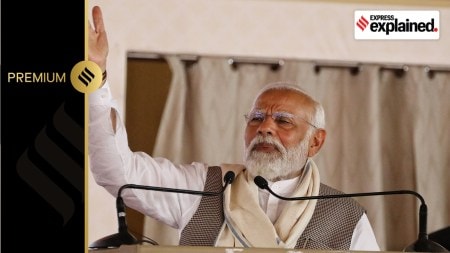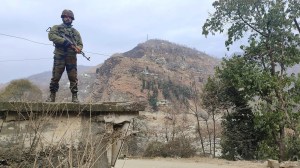- India
- International
How over millenia the Indus flowed into its present contested position between India and Pakistan
The Indus river is synonymous with the concept of India, flowing through its northwestern borders into the Arabian Sea. The history of the Indus includes tales of empires, conflict, civilisation and trade.
 The history of the Indus has profoundly influenced the Indian subcontinent, serving as a cradle of civilisation and a battlefield of war. It has shaped religion, identity, politics and culture, uniting empires and peoples shaped by the lifeblood of its waters.
The history of the Indus has profoundly influenced the Indian subcontinent, serving as a cradle of civilisation and a battlefield of war. It has shaped religion, identity, politics and culture, uniting empires and peoples shaped by the lifeblood of its waters. The Indus River has been intrinsically linked to the conceptualisation of Indian identity for millennia. Its settlers traded with Mesopotamia. Its grandeur was documented by the ancient Greeks and Persians. Both the Buddha and Guru Nanak bathed in its waters. Numerous foreign conquerors failed and while others succeeded in crossing the Indus, the intricate web of rivers flowing from Tibet to the Arabian Sea.
India and the Indus share not only history but entomology as well. In classical Sanskrit language, the Indus was known as Sindhu, the Persians called it Hindhu, and for the Greeks it was Indhu. From 300 BCE, the West knew only of India as a land bordering the Indus and thereafter, to the world, everything from Afghanistan to Sri Lanka would be known as the lands of Indika or India.
After the Partition, the new Muslim state could logically have laid claim to the name, given that the vast majority of the Indus and its five main trajectories were apportioned to it. However, Muhamad Ali Jinnah rejected the notion opting instead to christen the new country Pakistan, the Land of the Pure. Jinnah had assumed that New Delhi would similarly choose to forsake the colonial construct of India, naming their country Hindustan or Bharat instead. When they chose to continue using its British name, Jinnah was said to be furious, believing that by going by India, New Delhi was claiming superiority, relegating Pakistan to a mere breakaway state.
Most recently, the Indus has been a topic of fierce debate between India and Pakistan, particularly around issues of water sharing, in which, India holds the upper hand. To resolve the issue, the Indian and Pakistani governments, in collaboration with the World Bank, signed the Indus Water Treaty (IWT) in 1960. Despite tensions between the two nations, the treaty has endured, however, not without its fair share of controversy.
The Indian government has threatened to scrap the treaty on a number of occasions, notably during the military standoff of 2001-2002, and following the Uri terrorist attacks of 2016. This January, Prime Minister Narendra Modi, who once declared, “blood and water cannot flow together,” issued a formal notice to Pakistan for the treaty to be renegotiated. Chief amongst Indian concerns is lost hydropower revenue in Kashmir, Pakistani interference in projects planned on the western rivers, and the unequal distribution of rights in which India receives only 20 per cent of the Indus water flows. Thus far, there is a status quo, India’s hand somewhat tapered by the international implications of abandoning the IWT including Pakistani retaliation, the World Bank response, and the precedent it would set regarding India’s water treaties with China.

The history of the Indus has profoundly influenced the Indian subcontinent, serving as a cradle of civilisation and a battlefield of war. It has shaped religion, identity, politics and culture, uniting empires and peoples shaped by the lifeblood of its waters.
Battles of the Indus
Foreign conquerors have longed to cross the Indus since time immemorial, conflating the river with the rich subcontinent that stems from it. Although there are few historical accounts of the Indus predating the British, classical writers such as Arrian of Nicomedia have alluded to the fluidity of influences the region has been subjected to. He writes that the people living between the rivers Indus and Kabul “were in ancient times subject to the Assyrians, afterwards to the Medes and finally…to the Persians.”
The earliest documented foreign entity to conquer the Indus Valley was the Achaemenid Empire in the sixth century BCE. Under its founder, Cyrus the Great, and later, his successor, Darius, the Persians controlled parts of the Indian subcontinent ranging from west of the Indus up to the Jhelum river in Punjab.
The Achaemenians of Iran were overthrown by the forces of Alexander the Great in 326 BCE. Notably, Alexander’s last major battle was fought alongside the banks of the Jhelum River, the last part of the Achaemenid Empire that had failed to submit to the mighty Macedonian army. However, the battle severely weakened Alexander’s men who soon demanded to return home. Unable to convince them to keep marching on, Alexander sulkily retreated West, bringing with him tales of the mythical India with its fearless leaders, giant elephants and abundant rivers.
Another famous conqueror to reach the Indus was Genghis Khan in 1221 CE. After defeating the Shah of Khwarazm, Jalal-ad-Din, in Punjab, Genghis Khan’s formidable army stood victorious on the western banks of the Indus. As Jalal-ad-Din frantically escaped across the river, the Mongols were within tantalising reach of India, a land that then accounted for a third of the world’s GDP. The Mongols were a premier fighting force, having conquered much of China and Central Asia. The Delhi Sultanate, the strongest Indian entity at the time, would have been hard pressed to resist its advances. All Genghis Khan had to do was cross the river, but for reasons still unknown, he chose not to, sparing the Indus from any more bloodshed at his hands.
The last foreign power to invade the Indus were the British, who entered India by sea via the country’s western coast. For the British, the Indus was a vital barrier separating India from Central Asia and the vast reaches of the Russian Imperial Empire. As the author George Forester writes in From Bengal to England (1798), “the Indus forms a strong barrier to Hindostan on the west… Armies at all times have sustained difficulties and damage in crossing the Indus.” According to Alice Albina, author of Empire of the Indus (2008), Forester’s notion of the Indus as a military barrier was a “decisive” factor in the Company’s advance towards the river. She also notes that the fact that the Indus had been breached in the past was a source of great concern for the British, compelling them to lay their designs on the regions beyond it of Sindh and Afghanistan.
During the Great Game, Afghanistan was of paramount importance to the British, but access to it was blocked by the Indus, an entity that was only vaguely known to the Company based on anecdotal reports from Alexander’s expedition. To remedy the situation, the Company directed Alexander Burns, a Scottish explorer named after the great conqueror, to navigate the Indus by boat. However, as Burns documents in Voyage of the Indus (1834), the local leaders of Sindh, distrustful of Britain’s ambitions, were reluctant to sanction such a journey.
Burns had his way eventually, insisting that the British King’s present of five prize horses to Maharaja Ranjit Singh, the Lion of Punjab, would not survive the overland journey from Bombay to Lahore. Thus, he argued, the only way to ensure they reached safely was to transport them by boat up the Indus. In 1831, his voyage was approved, and his subsequent survey of the river system would prove invaluable to the British, paving the way for a future assault of Singh and Central Asia according to the historian Christopher Bayly, who wrote about the journey in Empire and Information (1996).
The Indus served the British in several ways. Not only did it provide them with a pathway into Punjab and Sindh, but it also helped consolidate control over their peoples. The British built a series of canals along the Indus, transforming a once arid region into fertile land. This now valuable agricultural land was then given to loyalists of the British like Baba Khem Bedi who received 7800 acres from the Company and in turn supported them during the Revolt of 1857.
Britain’s canal building project in the Indus Valley was lauded as a great success, both within and outside of India. As the University of Southampton Professor Ian Talbott writes in Punjab under Colonisation, “the transformation of six million acres of desert into one of the richest agricultural regions in Asia was a stupendous engineering feat that was seen as the colonial state’s greatest achievement.”
However, long before the British laid claim to the Indus, civilisations thrived along its banks.
Indus Valley Civilisations
Colonial Victorians had long portrayed the Indus Valley as “backward and unedifying” according to Albina, believing it to have only been enlightened through the foreign conquests of Alexander and the East Indian Company. In 1922, that conceptualisation dramatically changed after archaeologists discovered the remains of ancient civilisations around the Indus, in Afghanistan, Pakistan and north-western India.
Lasting from 3300 BCE to 1300 BCE, the Indus Valley Civilisation included thousands of individual cities and sites, each meticulously planned and highly engineered around the flow of water. Describing the advanced nature of the cities, historian Sailendra Nath Sen, alludes to their sophistication of design, cultural contributions, and global reach.
In Ancient Indian History and Civilisation (1999), he writes that the Indus people engaged with merchants from Mysore, South India, Central Asia, Persia, Egypt, and Mesopotamia, carrying “their trade far beyond the frontiers of the empire.” Additionally, he attributes many features of Hinduism to the influence of Indus culture, including the recurrent figures of Siva, phallus worship and the cult of the bull.
Eventually, the river that gave birth to the Indus Valley Civilisation, also precipitated its downfall. According to research conducted by Cambridge University, the Indus people revered and respected the river, adjusting to its frequent bouts of flooding and adapting to its unpredictable nature. However, over a 200-year period preceding 1300 BCE, drought transformed the environmental conditions of the Indus Valley, forcing its peoples to migrate towards the Ganges.
In the following thousands of years, a people known as the Aryans, speaking an Indo-European language, moved from Central Asia into northern India. This period, known as the Vedic Age, was documented in the Rig Vedas, an ancient text that described early Indian cultural traditions.
As numerous scholars have attested, the Ganges and Yamuna rivers were only mentioned in the Rig Vedas a handful of times, whereas the Sindhu is frequently evoked. One verse of the ancient text reads, “Sindhu’s roar rises high above the earth, right up to the heavens above…Sindhu leads all other rivers just as a warrior-king leads the rest of warriors…Rich in fine steeds is Sindhu; Rich in gold; nobly fashioned is Sindhu; rich in ample wealth is Sindhu.” For the Aryans, cleanliness and ritual purity were of special significance, their religion prioritising the Gods of Nature, and particularly the God of Rivers.
The Aryan Empire began to decline in around 500 BCE, with the Indus Valley passing between the Persians and the Greeks until Chandragupta Maurya defeated the Hellenistic army to gain control of areas west of the river in approximately 320 BCE. Although the Maurya dynasty was relatively short lived, its influence was unparalleled, putting most of the Indian subcontinent under the rule of one king for the first time.
India’s earliest civilisations, texts, religions, and rulers all derive, in part, from the lands around the Indus. India and Indus, irrevocably united in name, tradition and history until the fracturing of the subcontinent in 1947.
India, Pakistan, and the Indus
Water sharing disputes surrounding the Indus existed during the British Raj, but it was only after Partition that they took on national significance. When Cyril Radcliff, a man with little knowledge of India, was appointed to oversee the hasty geographical division of India and Pakistan, he drew his boundary lines with little consideration towards religion, demographics, or history. For all those limitations, however, he was acutely cognisant of the significance of the Indus, expressing hope that “some joint control and management of the irrigation system may be found”.
When the country was divided, Pakistan received the vast majority of the Indus River system but India, crucially, controlled its upstream supply. Both parties were unhappy with the arrangement. As the historian Ashutosh Misra writes in India Pakistan (2010), the Indians were displeased because Pakistan got 18 million acres of irrigated land for 22 million people in the Indus River system whereas India received five million acres for 20 million people. This situation was compounded by the exodus of the Partition which drove Hindus into Eastern Punjab, just out of reach of the fertile Pakistani lands that had once belonged to them.
Pakistan for its part was concerned about India’s ability to ‘turn off the tap’ or control the flow of the river through its upstream western tributaries. To protect Pakistani interests, a standstill agreement was reached in December 1947 which provided that the allocation of water in the Indus system would be maintained until March 1948. However, this time period coincided with the Pakistani skirmishes into Kashmir, and the subsequent request of the Maharaja of Kashmir for Indian forces to intervene.
The situation rapidly escalated and in April 1948, a month after the agreement expired, India weaponised its hydrological advantage, turning off the water flow into Pakistan. As a result, 5.5 per cent of the Pakistani land watered by canals dried up before the crucial sowing period. Karachi, inundated with refugees was in dire straits, as was Lahore, which had lost its main source of municipal water. With its back against the wall, the newly-formed Muslim homeland accepted ceasefire terms, ceding most of Kashmir to India.
The situation over Kashmir seemed to be temporarily resolved but that of the Indus still remained unanswered. For the international community, particularly the United States, this posed a considerable problem. India’s foreign policy was non-aligned, but Washington found a crucial strategic Cold War ally in Pakistan. In order for that relationship to bear fruit, Pakistan needed to survive, and to survive, it needed its main source of water – the Indus River.
The World Bank, under the de facto control of the US, soon entered the picture and after eight years of negotiations, helped broker the landmark IWT treaty between India and Pakistan in 1960. Under the IWT, the waters from three eastern Indus rivers were allocated to India and the three western rivers to Pakistan. The treaty also permits both countries to use the other’s rivers for certain purposes like hydroelectric projects, a clause that would prove controversial to implement in the 21st century.
According to Misra, “some in India saw the treaty as a loss” because it curtailed India’s rights on the western rivers and allocated New Delhi significant financial responsibility towards replacement works in Pakistan. For its part, Misra writes, “Pakistan had reasons to be satisfied with the treaty” as it ensured that India could not interfere with Pakistan’s irrigation needs. As to why the seemingly lopsided agreement was formed, two important factors must be considered. For one, India was far more concerned with the threat of China during that period, with Pakistani Prime Minister Ayub Khan even proposing a “joint India-Pakistan defence” as a symbol of their unity against a common threat. Secondly, the enormous financial responsibility of building new canals could not be met by either India or Pakistan but under the treaty, the World Bank would take responsibility for much of the development.
In the subsequent decades, India and Pakistan would teeter on the brink of permanent conflict but somehow the IWT has managed to survive. When everything else descended into chaos, the waters of the Indus inexplicably remained sacrosanct.
That being said, both countries have not abstained from attempting to weaponise it. In 1997, BJP leader LK Advani founded the Sindhu Darshan, an annual pilgrimage to Ladakh in order to purify the river with the waters of the Brahmaputra and Ganga before it flows into Pakistan. For the then Home Minister and his supporters, the Indus became a symbol of nationalism, an enduring reminder that the lands of Pakistan once belonged to India. For Islamabad, the Indus is non-negotiable as the main supplier of water for a country that is already amongst the most water-scarce in the world.
Apr 05: Latest News
- 01
- 02
- 03
- 04
- 05








































